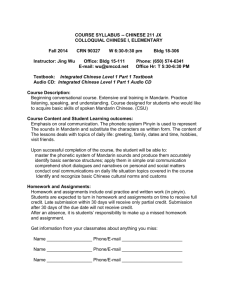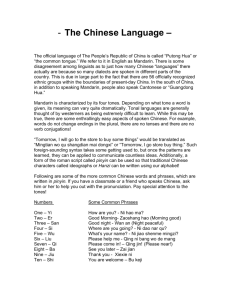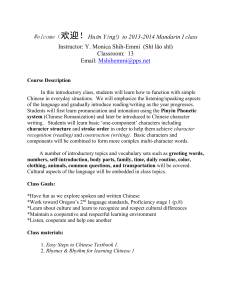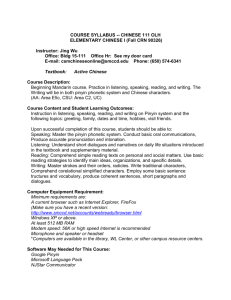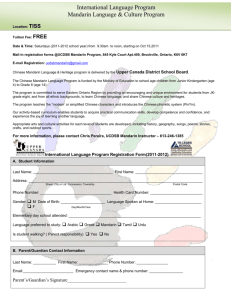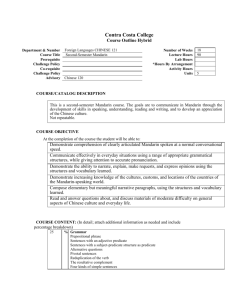College of San Mateo Official Course Outline COURSE ID: Semester Units/Hours:
advertisement
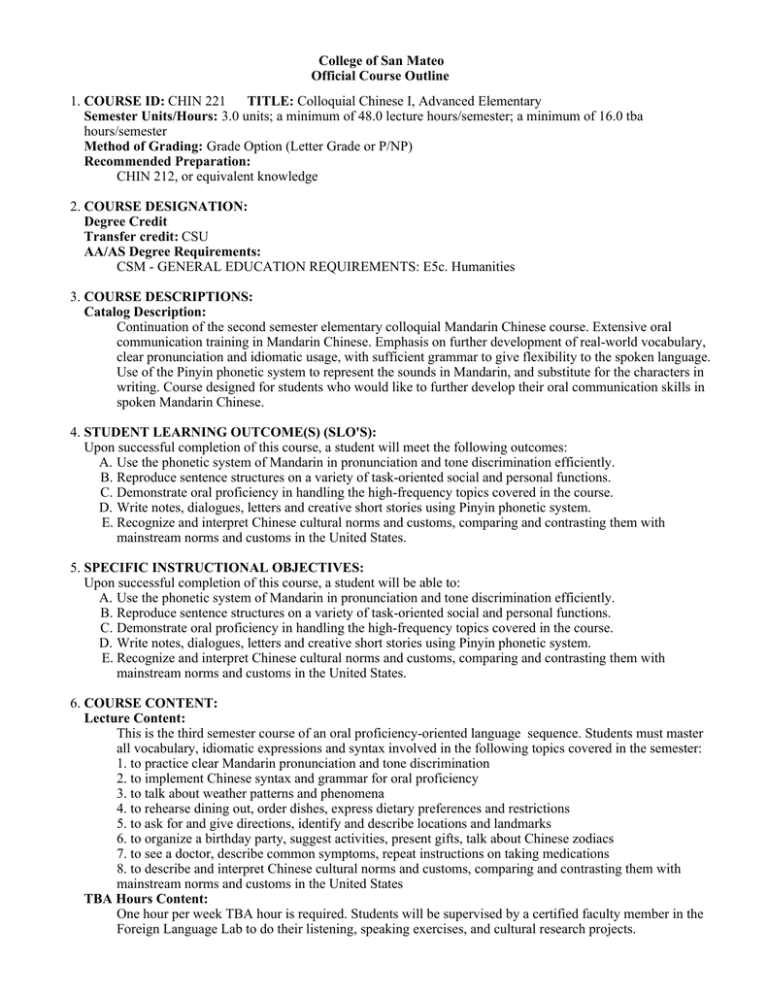
College of San Mateo Official Course Outline 1. COURSE ID: CHIN 221 TITLE: Colloquial Chinese I, Advanced Elementary Semester Units/Hours: 3.0 units; a minimum of 48.0 lecture hours/semester; a minimum of 16.0 tba hours/semester Method of Grading: Grade Option (Letter Grade or P/NP) Recommended Preparation: CHIN 212, or equivalent knowledge 2. COURSE DESIGNATION: Degree Credit Transfer credit: CSU AA/AS Degree Requirements: CSM - GENERAL EDUCATION REQUIREMENTS: E5c. Humanities 3. COURSE DESCRIPTIONS: Catalog Description: Continuation of the second semester elementary colloquial Mandarin Chinese course. Extensive oral communication training in Mandarin Chinese. Emphasis on further development of real-world vocabulary, clear pronunciation and idiomatic usage, with sufficient grammar to give flexibility to the spoken language. Use of the Pinyin phonetic system to represent the sounds in Mandarin, and substitute for the characters in writing. Course designed for students who would like to further develop their oral communication skills in spoken Mandarin Chinese. 4. STUDENT LEARNING OUTCOME(S) (SLO'S): Upon successful completion of this course, a student will meet the following outcomes: A. Use the phonetic system of Mandarin in pronunciation and tone discrimination efficiently. B. Reproduce sentence structures on a variety of task-oriented social and personal functions. C. Demonstrate oral proficiency in handling the high-frequency topics covered in the course. D. Write notes, dialogues, letters and creative short stories using Pinyin phonetic system. E. Recognize and interpret Chinese cultural norms and customs, comparing and contrasting them with mainstream norms and customs in the United States. 5. SPECIFIC INSTRUCTIONAL OBJECTIVES: Upon successful completion of this course, a student will be able to: A. Use the phonetic system of Mandarin in pronunciation and tone discrimination efficiently. B. Reproduce sentence structures on a variety of task-oriented social and personal functions. C. Demonstrate oral proficiency in handling the high-frequency topics covered in the course. D. Write notes, dialogues, letters and creative short stories using Pinyin phonetic system. E. Recognize and interpret Chinese cultural norms and customs, comparing and contrasting them with mainstream norms and customs in the United States. 6. COURSE CONTENT: Lecture Content: This is the third semester course of an oral proficiency-oriented language sequence. Students must master all vocabulary, idiomatic expressions and syntax involved in the following topics covered in the semester: 1. to practice clear Mandarin pronunciation and tone discrimination 2. to implement Chinese syntax and grammar for oral proficiency 3. to talk about weather patterns and phenomena 4. to rehearse dining out, order dishes, express dietary preferences and restrictions 5. to ask for and give directions, identify and describe locations and landmarks 6. to organize a birthday party, suggest activities, present gifts, talk about Chinese zodiacs 7. to see a doctor, describe common symptoms, repeat instructions on taking medications 8. to describe and interpret Chinese cultural norms and customs, comparing and contrasting them with mainstream norms and customs in the United States TBA Hours Content: One hour per week TBA hour is required. Students will be supervised by a certified faculty member in the Foreign Language Lab to do their listening, speaking exercises, and cultural research projects. 7. REPRESENTATIVE METHODS OF INSTRUCTION: Typical methods of instruction may include: A. Other (Specify): 1. Instructor lecture supported by using whiteboard and computer power point presentations. 2. Class activities, small group or paired partner practices throughout the instruction. 3. Use of authentic materials, such as DVD and audio CD of dialogues, narratives, TV shows and movies. 4. Student creation of sentences using specific grammatical structures and vocabulary. 5. Student productions of oral presentations, e.g. dialogues, storytelling, and short plays etc. 6. Use of visual materials to reinforce instruction and to give insight into the Chinese culture. Online instructional methods: The instructional media that will be used in this course are course website, textbook, worksheet, video, CD-ROM, bulletin board, discussion page, self-checking online exercises, online projects, email, phone, instructor office hours (online, phone, on campus). These multiple means of communication will ensure regular effective contact between the instructor and students, as well as interactions among students. 8. REPRESENTATIVE ASSIGNMENTS Representative assignments in this course may include, but are not limited to the following: Writing Assignments: Writing assignments (in Pinyin phonetic alphabet) including various writing formats and contents related to the chapter topics: write note, letter, narrative, dialogue, short advertisement, cultural research project report (in English), etc. Reading Assignments: Read text, reading comprehension practice and authentic materials, such as short story in Chinese newspaper, letter, advertisement, short play, subtitles in Chinese film. Other Outside Assignments: Listening and speaking assignments in cluding recorded listening exercise, dictation, group discussion, pair work to design dialogue, oral presentation, etc. 9. REPRESENTATIVE METHODS OF EVALUATION Representative methods of evaluation may include: A. 1. Class participation and performance. a. class preparation and participation; b. active involvement in various class communicative activities. 2. Timely completion of all assignments. a. oral presentations; b. pair or group projects c. oral and written (phonetic alphabet) assignments; d. online research projects 3. Periodic oral and written quizzes. 4. Comprehensive mid-term and final examinations. 10. REPRESENTATIVE TEXT(S): Possible textbooks include: A. De-an Wu Swihart. Success with Chinese Listening & Speaking Level 2, 1st ed. Cheng & Tsui Co., 2009 B. Yuehua Liu, Tao-chung Yao, Nyan-Ping Bi. Integrated Chinese Level 1 Part 2, 3rd ed. Cheng 7 Tsui Co., 2008 Origination Date: February 2012 Curriculum Committee Approval Date: May 2012 Effective Term: Fall 2013 Course Originator: Jing Wu
